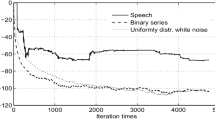Abstract
A stochastic approximation algorithm for estimating multichannel coefficients is proposed, and the estimate is proved to converge to the true parameters a.s. up-to a constant scaling factor. The estimate is updated after receiving each new observation, so the output data need not be collected in advance. The input signal is allowed to be dependent and the observation is allowed to be corrupted by noise, but no noise statistics are used in the estimation algorithm.
Similar content being viewed by others
References
Benveniste, A., Metivier, M. and Priouret, P. (1990), Adaptive Algorithms and Stochastic Approximations, Springer, Berlin.
Brandière, O. and Duflo, M. (1996), Les algorithmes stochastiques contournents-ils les pièges? Ann. Inst. Henri Poincaré, 32, 395-427.
Chen, H.F. (1994), Stochastic appoximation and its new applications, Proc. Hong Kong International Workshop on New Directions of Control and Manufacturing, pp. 2-12.
Chen, H.F. (1998), Stochastic approximation with non-additive measurement noise, J. Appl. Probab., 35, 407-417.
Chen, H.F., Cao, X.R. and Zhu, J., Recursive algorithms for multichannel blind identification, IEEE Trans. Information Theory, Vol. 48, No. 5, 2002, 1214-1225.
Ding, Z. and Li, Y. (1994), On channel identification based on second order cyclic spectra, IEEE Trans. Signal Process., 42, 1260-1264.
Hua, Y. and Wax, M. (1996), Strict identifiability of multiple FIR channels driven by an unknown arbitrary sequence, IEEE Trans. Signal Processing, 44, 756-759.
Kushner H.J. and Yin, G. (1997), Stochastic Approximation Algorithms and Applications, Springer, Berlin.
Liu, R. (1996), Blind signal processing: An introduction, Proc. 1996 Intl. Symp. Circuits and Systems, 2, 81-83.
Liu, H., Xu, G. Tong, L. and Kailath, T. (1996), Recent developments in blind channel equalization: From cyclostationarity to subspace, Signal Processing, 50, 516-525.
Moulines, E., Duhamel, P. Cardoso, J.-F. and Mayrargue, S. (1995), Subspace methods for the blind identification of multichannel FIR filters, IEEE Trans. on Signal Process., 43, 516-525.
Sato, D. (1975), A method of self-recovering equalization for multilevel amplitude-modulation, IEEE Trans. on Commun., 23, 679-682.
Tong L. and Perreau, S. (1998), Multichannel blind identification: From subspace to maximum likelihood methods, IEEE Proceeding, 86, 1951-1968.
Tong, L., Xu, G. and Kailath, T. (1994), Blind identification and equalization based on secondorder statistics: A time domain approach, IEEE Trans. Inform. Theory, 40, 340-349.
Tong, L., Xu, G. and Kailath, T. (1995), Blind channel identification based on second-order statistics: A frequency-domain approach, IEEE Trans. Inform. Theory, 41, 329-334.
van der Veen, A.J., Talwar, S. and Paulraj, A. (1995), Blind estimation of multiple digital signals transmitted over FIR channels, IEEE Signal Process. Lett., 2, 99-102.
Xu, G.H., Liu, H., Tong, L. and Kailath, T. (1995), A least-square approach to blind channel identification, IEEE Trans. Signal Process., 43, 2982-2993.
Zhao, Q. and Tong, L. (1999), Adaptive blind channel estimation by least squares smoothing, IEEE Trans. Signal Process., 47, 3000-3012.
Zhang, J.H. and Chen, H.F. (1997), Convergence of algorithms used for principal component analysis, Sci. in China (Series E), 40, 597-604.
Chen, H.F. (2002), Stochastic Approximation and its Applications, Kluwer Academic Publishers, Dordrecht.
Author information
Authors and Affiliations
Rights and permissions
About this article
Cite this article
Fang, HT., Chen, HF. Blind Channel Identification Based on Noisy Observation by Stochastic Approximation Method. Journal of Global Optimization 27, 249–271 (2003). https://doi.org/10.1023/A:1024851425821
Issue Date:
DOI: https://doi.org/10.1023/A:1024851425821




